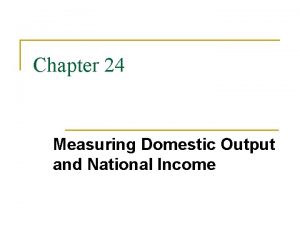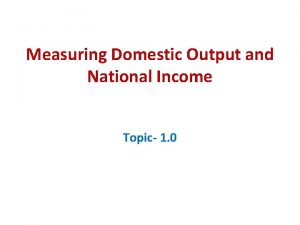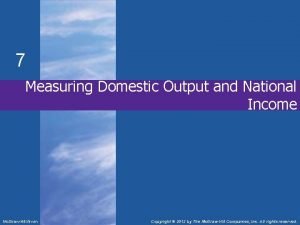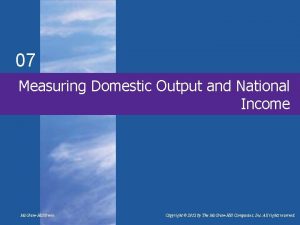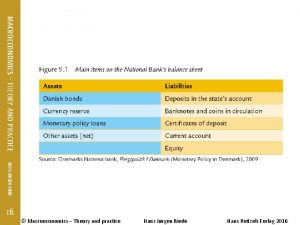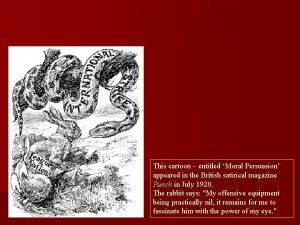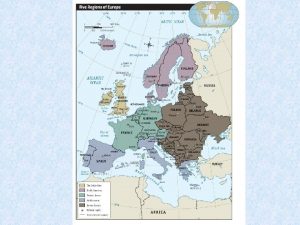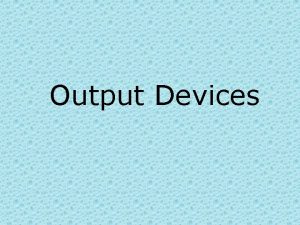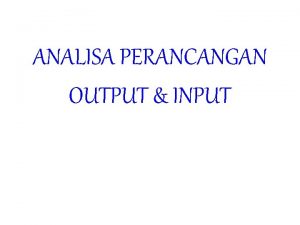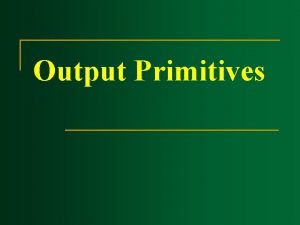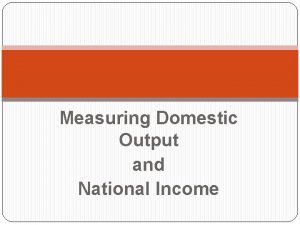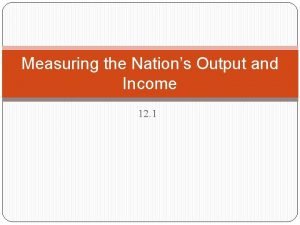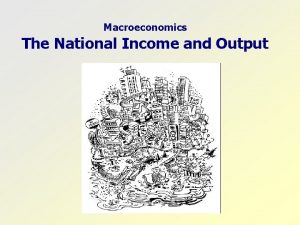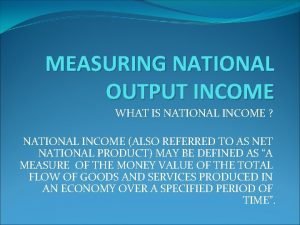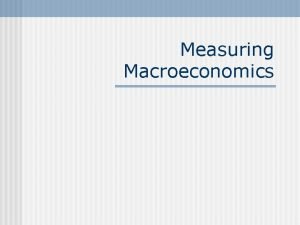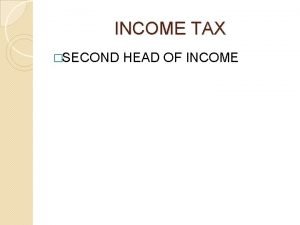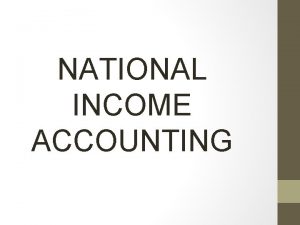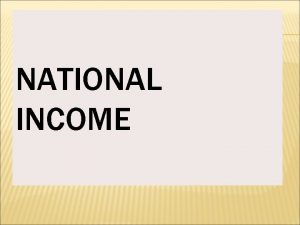Macroeconomics The Income and Output of Nations MACROECONOMICS





























































- Slides: 61

Macroeconomics The Income and Output of Nations

MACROECONOMICS – Microeconomics • Macroeconomics – International Trade – Development 1

ECONOMIC AGENTS Households FIRMS Government 2

Circular Flow Between Firms and Households (real resources) Goods and services Households Firms FOP Input: Household includes workers, managers, entrepreneurs etc 3

Circular Flow Between Firms and Households (corresponding flow of payments) Spending on goods and services Households Firms FOP incomes 4

Circular Flow Between Firms and Households Spending on goods and services Goods and services Households Firms Services of productive factors Factor incomes 5

Three measures of national output • Expenditure – the sum of expenditures in the economy • Income – the sum of incomes all factor incomes • Output – the sum of output (value added) produced in the economy • All three approaches are should give you the same final figure for national output 6

Circular Flow Between Firms and Households e h t y g m Spending on n Expenditure i no goods and servicesur o s c a e e e Goods. Output and services m h t f o in y y a t i w Households v i Firms t t n ac e r fi fe mic. Services of d oproductive factors 3 on ec Income Factor incomes 7

Measuring Output • Total value added – is the economy’s net output after deducting goods used during production – to avoid double counting – E. g. egg, milk, flour used for making muffins. MUFFINS. Final Good. • Gross domestic product (GDP) – measures the output produced by factors of production located in the domestic economy over a period of time, usually a year. 8

Leakages from the Circular Flow • Leakages (in terms of flow of payment) – money paid to the households but not returned to firm – Or flow of payments that started from firms but did not return back to firms – e. g. household savings, net taxes and imports 9

Circular Flow Between Firms and Households (corresponding flow of payments) Spending on goods and services Leakages Households Firms Factor incomes 10

Injections into the Circular Flow • Injections (in terms of flow of payment) – are revenue for firms not from sales to household – e. g. investment by firms, government purchases and exports 11

Circular Flow Between Firms and Households (corresponding flow of payments) Spending on goods and services Injections Households Firms Factor incomes 12

The Circular Flow of Income with Government and Foreign Trade • Government – spends money on goods & services (G) – finances welfare payments, i. e. transfer payments (B) this spending is financed by taxes (T) Foreign Sector: • Export (X) – made at local economy but sold abroad • Import (M) – made abroad and bought at local economy. 13

The Circular Flow of Income in Symbols • Domestic Output (GDP) is either – – Consumed (C) Invested (I) (INCREASE IN STOCK OF CAPITAL) Bought by the Government (G) Bought by the foreigners, net exports (X-M) • Factor Incomes are spent on – Consumption (C) – Saving (S) – Paying taxes net of benefits (T-B) 14

The Circular Flow of Income in Symbols GDP = C + I + G + (X – M) Factor Income = C + S + (T – B) Since every things produced in the economy generates equivalent factor income Domestic Output (GDP) = Factor Incomes 15

The Circular Flow of Income in Symbols Domestic Output Factor Incomes C + I + G + (X – M) = C + S + (T – B) C: Consumption I: Investment G: Government Expenditure X-M: Net exports C: Consumed S: Savings T-B: Taxes Net of Benefits 16

The Circular Flow of Income in Symbols Domestic Output Factor Incomes C + I + G + (X – M) = C + S + (T – B) rearrange I+G+X = Total Injections S + (T – B) + M Total Leakages 17

NATIONAL INCOME (GDP) • • • Y= National Income C = Consumption I = Investment G = Government Expenditure (X-M) =Net Exports GDP = C + I + G + (X – M) 18

IF ALL THAT IS PRODUCED, IS CONSUMED, THEN Y = C. • However all the revenue coming from national production is not used for consumption: © – T – S – M • Also the national production is not consumed by national local households. © Part of it goes to: Foreign countries, Government buys part of it and Some of the production is used for producing other goods: Investment. – X – G – I Therefore… I+G+X = Total Injections S + (T – B) + M Total Leakages 19

PRODUCTION AND GROWTH • GDP is a stock variable. Fixed in a specific time. An absolute figure. • Growth is a flow variable. Measures the change over time. Therefore measures a change over time. A rate or %. 20

Flow or stock? 21

Flow or stock? 22

23

GDP, GNP, • Gross domestic product (GDP) – measures the output produced by factors of production located in the domestic economy over a period of time, usually a year. • Gross National Product (GNP) – total income of citizens wherever it is earned = GDP + Net Property Income (NPI) IF GDP > GNP the citizens of the local economy are producing less than the citizens from abroad. It means that citizens from abroad in the local economy plus loclas make the local economy GDP bigger than its Citizens abroad and in the local economy together. Depreciation: wear and tear of capital stock Gross: DOES NOT TAKE IN ACCOUNT DEPRECIATION. Only the increase in K stock. • Net National Income = GNP – Depreciation 24

GDP, GNP, Depreciation • Nominal Gross National Product – Measures national output at current prices = value of all goods at current prices • Real Gross National Product – Measures output at base year prices e. g. value of today's national output at 1995 prices – Allows us eliminate the effect of price changes and see how real output evolves over time 25

GDP, GNP, Depreciation GNP Deflator for year t = Nominal GNP for year t Real GNP for year t Changes in GNP Deflator allows us to isolate the effect of increasing prices on Nominal GNP 26

Prices increase but productivity does not increase: Inflation • Inflation: A sustained increase in general price level of the economy over time. • If prices index in base year t: 100 • And if changes to year t 1: 105, the increase will be : _____. Year ∆ Prices ∆Nominal GDP 92 2% 7% 93 2. 5% 7. 5% 94 4% 7% 95 3% 7% 96 2. 5% 6. 5% 97 1% 6% 98 2% 6% ∆ Real GDP 27

EXAMPLE 28

Purchasing Power Parity • Purchasing power parity (PPP) conversion factor. The PPP conversion factor shows how much of a country's currency is needed in that country to buy what $1 would buy in the United States. • By using the PPP conversion factor instead of the currency exchange rate, we can convert a country's GNP per capita calculated in national currency units into GNP per capita in U. S. dollars while taking into account the difference in domestic prices for the same goods. • Thus PPP helps us compare GNPs of different countries more accurately. Because prices are usually lower in developing countries, their GNP per capita expressed in PPP dollars is higher than their GNP per capita expressed in U. S. dollars. 29

The Big Mac Index • Burgernomics is based on theory of purchasing-power parity, the notion that a dollar should buy the same amount in all countries. • Thus in the long run, the exchange rate between two countries should move towards the rate that equalizes the prices of an identical basket of goods and services in each country. • Our "basket" is a Mc. Donald's Big Mac, which is produced in about 120 countries. The Big Mac PPP is the exchange rate that would mean hamburgers cost the same in America as abroad. • Comparing actual exchange rates with PPPs indicates whether a currency is under- or overvalued. 30

TOTAL GDP enough? • GDP 1: 10, 000$ • Population 1: 5, millions – Gdp / capita: 2$ • GDP 2: 10, 000$ • Pop 2: 700, 000 – Gdp/capita: 14. 2$ • GDP 3: 50, 000 • Pop 3: 28 millions – Gdp/capita: 1. 78$ 31

GDP/capita in different countries 32

GDP compared 33

GDP Composition 34

GDP per capita 35

GDP AND GDP/Capita WORLD 36

POPULATION GROWTH RATE 37

GROWTH, POPULATION AND GNP/CAPITA 38

Income per capita 39

GNP per capita growth rates 40

REAL GDP PER CAPITA 41

National Income and Firm Sales 42

TOTAL GDP is ok, but not enough… GDP measures production in an economy…HOWEVER: • Does NOT take in account other variables like: – – Does not separate K or C goods. Underground economy is not taken in account Externalities are not taken in account. Self consumption activities or household activities are not taken in account. – Other issues which reflect standard of living. Education, Health, environment, security, freedom, discrimination, etc… – Income distribution (inequality) 43

Unequal distribution of Income 44

THEREFORE: DEVELOPMENT INDEXES ARE NEEDED TO EXPLAIN WELL BEING IN AN ECONOMY. 45 World dev

Growth and Development • Millennium Development Goals 46

Growth and Development

WHY COUNTRIES GROW? • Technology= increase in productivity of other factors. 48

Technology and Mg productivity of labour 49

Economic Growth • Growth: An increase in an economy's ability to produce goods and services which brings about a rise in standards of living. • The increase over time in the capacity of an economy to produce goods and services and (ideally) to improve the well-being of its citizens. 50

Development • Economic Development: The process of improving the quality of human life through increasing per capita income, reducing poverty, and enhancing individual economic opportunities. • Economic Development: is typically measured in terms of jobs and income, but it also includes improvements in human development, education, health, choice, and environmental sustainability The power of one: hyperlink 51

DEVELOPMENT 52

HOWEVER: Difficulties to measure development • • Subjective Variables (culture and religion? ) Difficult to measure Not available statistics Different indicators to compare development between countries and Institutions. (U. N. , WB, WTO, IMF, etc) • LDC, MDC, etc… • Read pp 30, 31, 32 green book 53

World Bank Income Classification: • Income group: Economies are divided according to 2006 GNI per capita. • The groups are: – low income: $905 or less; – lower middle income: $906 - $3, 595; – upper middle income: $3, 596 - $11, 115; and – high income: $11, 116 or more. 54

World: GNP per capita Countries Classifications 55

U. N. HDI Classification 56

High Human development • • • 1 -Iceland Norway Australia Canada Ireland Sweden Switzerland Japan Netherlands France Finland United States Spain Denmark Austria United Kingdom Belgium Luxembourg New Zealand Italy Hong Kong, China (SAR) Germany Israel Greece Singapore Korea, Rep. of Slovenia Cyprus Portugal Brunei Darussalam Barbados Czech Republic Kuwait Malta Qatar Hungary Poland Argentina United Arab Emirates Chile Bahrain Slovakia Lithuania Estonia Latvia Uruguay Croatia Costa Rica Bahamas Seychelles Cuba Mexico Bulgaria Saint Kitts Nevis Tonga Libyan Arab Jamahiriya Antigua and Barbuda Oman Trinidad and Tobago Romania Saudi Arabia Panama Malaysia Belarus Mauritius Bosnia Herzegovina Russian Federation Albania Macedonia, TFYR Brazil-70 57

Medium Human Development • • • Dominica Saint Lucia Kazakhstan Venezuela, Rep. Bov. Colombia Ukraine Samoa Thailand Dominican Republic Belize China Grenada Armenia Turkey Suriname Jordan Peru Lebanon Ecuador Philippines Tunisia Saint Vincent and the Grenadines Fiji Iran, Islamic Rep. of Paraguay Georgia Guyana Azerbaijan Sri Lanka Maldives Jamaica Cape Verde El Salvador Algeria Viet Nam Occupied Palestinian Territories Indonesia Syrian Arab Republic Turkmenistan Nicaragua Moldova Egypt Uzbekistan Mongolia Honduras Kyrgyzstan Bolivia Guatemala Gabon Vanuatu South Africa • • Tajikistan São Tomé and Principe Botswana Namibia Morocco Equatorial Guinea India Solomon Islands Lao, People's Dem. Rep. Cambodia Myanmar Bhutan Comoros Ghana Pakistan Mauritania Lesotho Congo Bangladesh Swaziland Nepal Madagascar Cameroon Papua New Guinea Haiti Sudan Kenya Djibouti Timor-Leste Zimbabwe Togo Yemen Uganda Gambia 58

Low Human Development • Senegal Eritrea Nigeria Tanzania, U. Rep. of Guinea Rwanda • Angola Benin Malawi Zambia Côte d'Ivoire Burundi Congo, Dem. Rep. Ethiopia Chad Central African Republic Mozambique Mali • Niger Guinea-Bissau Burkina Faso Sierra Leone 59

Development Link to presentation 19 mins Examination: Dr microeconomics March 6 th. 60
 Personal income formula in national income
Personal income formula in national income Carrying amount formula
Carrying amount formula Operating income meaning
Operating income meaning Calculate income tax
Calculate income tax Measuring domestic output and national income
Measuring domestic output and national income Measuring domestic output and national income
Measuring domestic output and national income Measuring domestic output and national income
Measuring domestic output and national income Measuring domestic output and national income
Measuring domestic output and national income Hình ảnh bộ gõ cơ thể búng tay
Hình ảnh bộ gõ cơ thể búng tay Ng-html
Ng-html Bổ thể
Bổ thể Tỉ lệ cơ thể trẻ em
Tỉ lệ cơ thể trẻ em Voi kéo gỗ như thế nào
Voi kéo gỗ như thế nào Chụp phim tư thế worms-breton
Chụp phim tư thế worms-breton Hát lên người ơi alleluia
Hát lên người ơi alleluia Các môn thể thao bắt đầu bằng tiếng bóng
Các môn thể thao bắt đầu bằng tiếng bóng Thế nào là hệ số cao nhất
Thế nào là hệ số cao nhất Các châu lục và đại dương trên thế giới
Các châu lục và đại dương trên thế giới Công thức tính thế năng
Công thức tính thế năng Trời xanh đây là của chúng ta thể thơ
Trời xanh đây là của chúng ta thể thơ Mật thư anh em như thể tay chân
Mật thư anh em như thể tay chân Phép trừ bù
Phép trừ bù độ dài liên kết
độ dài liên kết Các châu lục và đại dương trên thế giới
Các châu lục và đại dương trên thế giới Thể thơ truyền thống
Thể thơ truyền thống Quá trình desamine hóa có thể tạo ra
Quá trình desamine hóa có thể tạo ra Một số thể thơ truyền thống
Một số thể thơ truyền thống Cái miệng bé xinh thế chỉ nói điều hay thôi
Cái miệng bé xinh thế chỉ nói điều hay thôi Vẽ hình chiếu vuông góc của vật thể sau
Vẽ hình chiếu vuông góc của vật thể sau Thế nào là sự mỏi cơ
Thế nào là sự mỏi cơ đặc điểm cơ thể của người tối cổ
đặc điểm cơ thể của người tối cổ Ví dụ về giọng cùng tên
Ví dụ về giọng cùng tên Vẽ hình chiếu đứng bằng cạnh của vật thể
Vẽ hình chiếu đứng bằng cạnh của vật thể Vẽ hình chiếu vuông góc của vật thể sau
Vẽ hình chiếu vuông góc của vật thể sau Thẻ vin
Thẻ vin đại từ thay thế
đại từ thay thế điện thế nghỉ
điện thế nghỉ Tư thế ngồi viết
Tư thế ngồi viết Diễn thế sinh thái là
Diễn thế sinh thái là Các loại đột biến cấu trúc nhiễm sắc thể
Các loại đột biến cấu trúc nhiễm sắc thể So nguyen to
So nguyen to Tư thế ngồi viết
Tư thế ngồi viết Lời thề hippocrates
Lời thề hippocrates Thiếu nhi thế giới liên hoan
Thiếu nhi thế giới liên hoan ưu thế lai là gì
ưu thế lai là gì Hổ đẻ mỗi lứa mấy con
Hổ đẻ mỗi lứa mấy con Khi nào hổ con có thể sống độc lập
Khi nào hổ con có thể sống độc lập Sơ đồ cơ thể người
Sơ đồ cơ thể người Từ ngữ thể hiện lòng nhân hậu
Từ ngữ thể hiện lòng nhân hậu Thế nào là mạng điện lắp đặt kiểu nổi
Thế nào là mạng điện lắp đặt kiểu nổi Micro economics example
Micro economics example Macroeconomics? - definition and examples
Macroeconomics? - definition and examples New classical and new keynesian macroeconomics
New classical and new keynesian macroeconomics Nicepp
Nicepp Macroeconomics theory and practice
Macroeconomics theory and practice New classical and new keynesian macroeconomics
New classical and new keynesian macroeconomics Undss
Undss International strife cartoon meaning
International strife cartoon meaning Physical characteristics of nordic nations
Physical characteristics of nordic nations Ethics and integrity at the united nations
Ethics and integrity at the united nations Superimposed boundary
Superimposed boundary The british isles and nordic nations map
The british isles and nordic nations map




